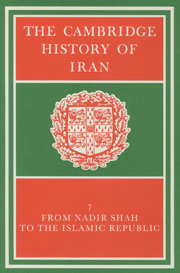Book contents
- Frontmatter
- PART 1 THE POLITICAL FRAMEWORK, 1722–1979
- PART 2 FOREIGN RELATIONS
- PART 3 ECONOMIC AND SOCIAL DEVELOPMENTS
- PART 4 RELIGIOUS AND CULTURAL LIFE, 1721–1979
- 19 RELIGIOUS FORCES IN EIGHTEENTH- AND NINETEENTH-CENTURY IRAN
- 20 RELIGIOUS FORCES IN TWENTIETH-CENTURY IRAN
- 21 POPULAR ENTERTAINMENT, MEDIA AND SOCIAL CHANGE IN TWENTIETH-CENTURY IRAN
- 22 PRINTING, THE PRESS AND LITERATURE IN MODERN IRAN
- 23 PERSIAN PAINTING UNDER THE ZAND AND QĀJĀR DYNASTIES
- 24 THE ARTS OF THE EIGHTEENTH TO TWENTIETH CENTURIES
- Genealogical tables
- Bibliographies
- Index
- References
24 - THE ARTS OF THE EIGHTEENTH TO TWENTIETH CENTURIES
from PART 4 - RELIGIOUS AND CULTURAL LIFE, 1721–1979
Published online by Cambridge University Press: 28 March 2008
- Frontmatter
- PART 1 THE POLITICAL FRAMEWORK, 1722–1979
- PART 2 FOREIGN RELATIONS
- PART 3 ECONOMIC AND SOCIAL DEVELOPMENTS
- PART 4 RELIGIOUS AND CULTURAL LIFE, 1721–1979
- 19 RELIGIOUS FORCES IN EIGHTEENTH- AND NINETEENTH-CENTURY IRAN
- 20 RELIGIOUS FORCES IN TWENTIETH-CENTURY IRAN
- 21 POPULAR ENTERTAINMENT, MEDIA AND SOCIAL CHANGE IN TWENTIETH-CENTURY IRAN
- 22 PRINTING, THE PRESS AND LITERATURE IN MODERN IRAN
- 23 PERSIAN PAINTING UNDER THE ZAND AND QĀJĀR DYNASTIES
- 24 THE ARTS OF THE EIGHTEENTH TO TWENTIETH CENTURIES
- Genealogical tables
- Bibliographies
- Index
- References
Summary
ARCHITECTURE
Introduction
“At a distance, Tehran, built in great part of the mud on which it stands, is only distinguished from the surrounding plain by the green trees of its many gardens; but as the traveller gets nearer he will see the outline of the castellated city wall and the tiled domes and minarets of mosques. He will enter the town by a grandiose gateway adorned with glazed bricks in patterns, the prevailing tones being blue and yellow relieved with black and white, the whole giving a touch of splendour to its squalid surroundings. These gateways are twelve in number; some are adorned with the exploits of Rustum, the Hercules and knight-errant of Persia, and others depict the Persian soldier of today”. This picture of Tehran, as drawn by Ella Sykes in 1894, is an appropriately evocative introduction to the architecture of the period since it is the buildings which give the city its unfamiliar exotic appearance. Her account is one of the more sympathetic of the many written in tones ranging from wonder, disparagement and sarcasm to sober assessment by the Europeans who visited Tehran since it became Iran's capital in 1786. Most 19th-century Persian cities of any size presented a similar architectural pattern. City sites tended to have a long history of occupation. A harsh terrain and climate severely limited areas of settlement; communication difficulties in a large country made it essential that a city was sited in a good strategic position, preferably on a trade route; proximity to a water supply was vital near foothills whose water-tables would feed qanāts.
- Type
- Chapter
- Information
- The Cambridge History of Iran , pp. 890 - 958Publisher: Cambridge University PressPrint publication year: 1991
References
- 1
- Cited by



